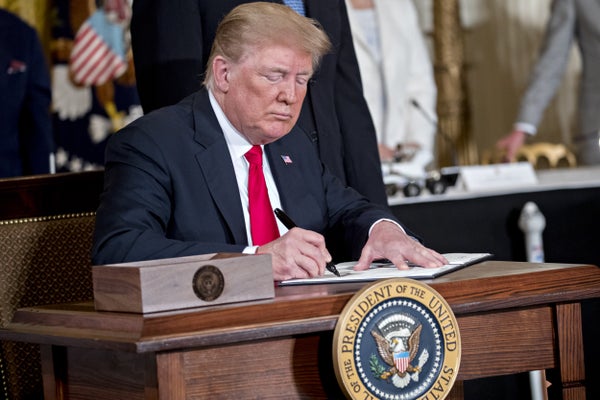President Donald Trump directed officials Monday (June 18) to establish a military Space Force before signing a new U.S. policy for space traffic control. The measure, he said, is another step forward in U.S. leadership in space.
Trump spoke at the third public meeting of the newly-reinstated National Space Council, chaired by Vice President Mike Pence and hosted at the White House, and officially signed the council’s third space policy directive. This document concerns monitoring objects in orbit and sharing the information so spacecraft can avoid collisions. But near the beginning of his remarks, Trump focused on the security implications of operating in space.
“The essence of the American character is to explore new horizons and to tame new frontiers,” Trump said in his opening remarks. “But our destiny beyond the Earth is not only a matter of national identity, but a matter of national security so important for our military. ... When it comes to defending America, it is not enough to merely have an American presence in space. We must have American dominance in space.”
On supporting science journalism
If you're enjoying this article, consider supporting our award-winning journalism by subscribing. By purchasing a subscription you are helping to ensure the future of impactful stories about the discoveries and ideas shaping our world today.
He then directed the Department of Defense and the Pentagon to establish a Space Force as the sixth branch of the armed forces.
Next, he moved on to the directive of the day, whose goal is to reduce encroaching space debris.
“I am instructing my administration to embrace the budding commercial space industry,” Trump said. “We are modernizing out-of-date space regulations … and today we’re taking one more step to unleash the power of American ingenuity. In a few moments, I will sign a new directive to federal departments and agencies. They will work together with American industry to implement a state-of-the-art framework for space traffic management—but don’t let [the regulations] get too out of control, please.”
The administration’s first space policy directive, signed Dec. 11, 2017, called for NASA to focus on returning humans to the moon. The second directive, signed May 24 of this year, called for new regulations for launch and re-entry that would encourage more commercial-spaceflight operations.
Scott Pace, the executive secretary of the National Space Council, offered more details in an email about the directive and how it would be budgeted.
“Each agency will continue to have their own budgets for space traffic management,” Pace told Space.com. “In general, NASA will be doing supporting research, Defense will be doing more work related to national security, Transportation will be streamlining its licensing processes, and Commerce will be putting more resources into public and industry interfaces.”
“In general, I would expect Commerce to need more resources to carry out its new responsibilities,” he added. “Any issues will be dealt with in the FY2020 [fiscal year 2020] budget process, so it’s hard to say now what the final numbers will be.”
Trump—echoed by others later in the meeting—reiterated that the United States is heading back to the moon and emphasized that it will be for the long haul. (NASA’s current next step for the moon, the Deep Space Gateway, would be an orbiting outpost for research and missions to the surface.)
“This time, we will do more than plant our flag and leave our footprints. We will establish a long-term presence, expand our economy and build the foundation for an eventual mission to Mars, which is actually going to happen very quickly,” he said. Trump mentioned that he’d be just as happy if U.S. private space industries reached Mars before NASA. “If you beat us to Mars, we’ll be very happy and you’ll be very famous,” he said.
During the body of the meeting, panelists discussed work on commercial remote sensing licenses, launch regulations that will stem from the second space policy directive, the best strategies to return to the moon and future exploration missions. NASA astronauts Eileen Collins, Terry Virts and Scott Parazynski also spoke, calling for a clear action-plan toward the country’s space exploration goals. Virts also told the council that the Deep Space Gateway was the wrong approach for the agency; he said it replicated what the International Space Station had already achieved. They all emphasized the importance of international collaboration and a detailed long-term plan that can last beyond one administration.
Trump’s final words in the introductory speech addressed the space industry representatives and others in the room who are making spaceflight possible.
“You will go out there, and you will take that frontier, which is largely unknown, by man or woman, and you will learn everything there is to know about it,” he said. “What you’re doing is so important, remember—economically, militarily, scientifically, in every way, there’s no place like space.”
Copyright 2018 SPACE.com, a Purch company. All rights reserved. This material may not be published, broadcast, rewritten or redistributed.
